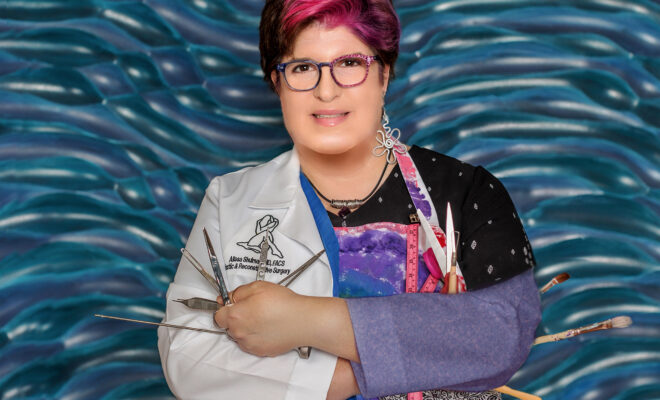
Feature
Advice from a Top Plastic Surgeon: Dr. Alissa Shulman Shares Advice and Tips
July 2023—Board-certified plastic surgeon and lifelong artist and sculptor Dr. Alissa Shulman, M.D., F.A.C.S, is known for being a great listener who gets to know each patient and assess what’s important to them and what is realistic. She promotes healthy lifestyles and patient education to ensure the results she achieves will last.
Dr. Shulman has served as Section Chief of Plastic Surgery at Sarasota Memorial Hospital since 2011 and was the first woman to be named Chief of Surgery from 2015 to 2016. She was Sarasota Memorial Hospital’s 2017 Physician of the Year, Chief of Staff at Sarasota Memorial Hospital in 2020, and President of the Florida State Society of Plastic Surgeons in 2020.
We asked Dr. Shulman to share a few of the questions and concerns she hears from her patients and she kindly obliged!
My implants are getting close to 10 years old. What should I do?
Are you having a problem with the implants? Do you still like, or even need them? Specifically, how have you and your breasts aged?
If you still like your implants and how they look, honestly, just leave them alone for now. The ten-year timeframe was created somewhat arbitrarily. Recent recommendations by the FDA include routine evaluations—all paid for by the patient. If implants were put in for cosmetic reasons, an insurance company is very unlikely to cover removal.
If there is a clinical problem, then it is unlikely that a radiologic exam is going to change the recommendation for implant removal. If there is no clinical problem, and you are happy, I recommend leaving them until you are unhappy or there is a problem.
Fortunately, as we age, our breast tissue usually expands as the density decreases. There is often more tissue than you remember, and more skin droop. Another issue with aging is image. The larger and curvy breasts of youth turn into the matronly breasts of maturity. Sorry ladies!
Whenever possible, I often recommend implant removal and mastopexy (breast lift). If we still need a little more upper breast volume, I can usually find some unnecessary fat to transfer to the breast.
The one surgery I usually try to avoid these days is implant replacement in the mature breast. Patients are rarely as happy with the replacement as they were with their original implants.
Patients cannot help but remember what their breasts originally looked like, and do not fully accept the natural change of aging—skin support, tissue density, and more. I believe as we age, our chance of developing breast cancer increases, and examination of the breast should be made simpler.
This is a very good conversation to have with your plastic surgeon.
My pants don’t fit, but my weight is still the same. What’s going on and what can be done?
If you are in your menopausal years and have likely lost an inch or two of height, this is a natural byproduct of aging and “shrinkage”. When one loses height, it is lost in the lower torso. However, the same intra-abdominal contents exist and take up the same volume as it always did. Your internal organs need somewhere to go, so decreased length becomes increased width. There is no actual “fix” for this, there is no option to re-lengthen the spine.
An abdominoplasty may tighten the abdominal skin, but the resulting appearance would be both tighter and rounder (not smaller) and ultimately worse. If there is any significant external pinchable fat, liposuction may result in a smaller waistline. This is best done as a circumferential liposuction—removing a little bit of fat at the waistline and flank. This may also create the illusion of a longer torso.
My breasts are droopy, and I have lost my upper pole fullness. Do I need implants?
Most likely you only “need” a mastopexy (breast lift). Implants only make the breasts larger and don’t truly lift anything. Ultimately, implants used to lift ultimately result in more droop and more skin. Often, implants commit you to more surgery. An aggressive breast lift can be combined with a little fat grafting (injecting drops of fat in the hollow areas) to achieve a youthful appearance. If there is ample native volume, then an aggressive lift is the best option, and it’s all still you.
When I wave, my upper arms wave back.
Unless there is a true “wing deformity” (so much excess skin that it looks like a bird wing), there is likely just a small amount of excess skin superimposed on a relaxed triceps muscle. When you wave, you are partially flexing your biceps muscles, but your triceps are fully relaxed and “floppy” (giving the appearance of a loose upper arm). A good test for this is to flex your triceps muscles while strongly extending your arm, and check for any extra hanging skin. If there is none, or a minimal amount, then it is best to add weightlifting to your exercise routine. This will increase your muscle volume and help shape this upper arm area. If there is still true excess skin, then a brachioplasty might be a good option. Please understand that this procedure leaves a very visible scar.



You must be logged in to post a comment Login